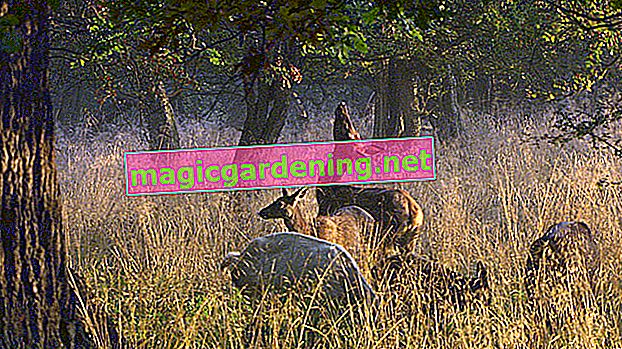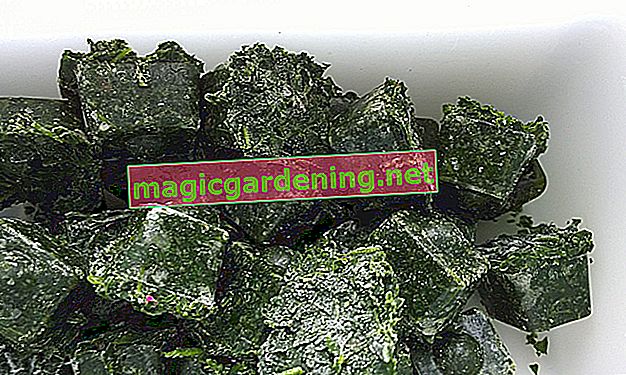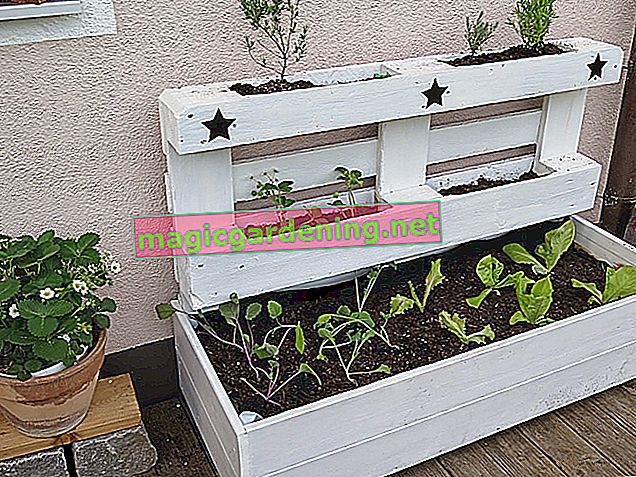
the essentials in brief
- Wood lice can be killed with kieselguhr. Beneficial insects are a gentler option.
- Most of the time, simple home remedies are enough to get rid of the woodlice. They can be attracted by potatoes or damp towels and can easily be brought outside.
- In order for them not to come back, the causes must be researched and eliminated. Wood lice like moist conditions and take on useful tasks as decomposers. They prefer to live close to humans.
- Wood lice protect their offspring in a special way. They differ from insects and have unique ways of life. With their breathing and excretion, they are adapted to country life.
How can we fight wood lice?
The tadpole shrimp can be fought with simple means so that you don't have to resort to poison immediately. Think about whether you really need to kill the animals. In the rarest of cases, woodlice become a nuisance, so that you can get the woodlice out of the house with careful measures.
also read
- The secret life of the hover fly
- The secret life of the great angle spider
- From the life of thunderstorm animals
Kieselguhr

If you want to destroy basement lice without chemical means, diatomaceous meal will prove effective. The powder, which is made from fossil diatoms, is fine as dust and consists of sharp-edged crystals with a large surface. It is not dangerous for users and is used to destroy numerous arthropods.
Application:
- Apply in cracks and crevices
- Sprinkle high traffic area
- Distribute around a lure
The fine crystals clog the breathing openings that are spread over the body. As a result, the wood lice can no longer breathe and suffocate. With regular and direct use, wood lice should no longer be a problem within four days.
Use beneficial insects
Nematodes of the species Steinernema carpocapsae have been used successfully for some time to control woodlice. The roundworms are not mobile themselves, which is why they are used in the form of traps. There is an attractant in the trap that attracts the wood lice. Upon contact, the nematodes penetrate the woodlice, where they secrete bacteria. These decompose the arthropod from the inside. Such traps only work at temperatures above twelve degrees, since the activity of the nematode is stopped under these conditions.
Effective home remedies
You can use simple methods to catch or scare the animals. Attractants work all the better once you have eliminated the cause of the lice infestation. Then the crustaceans will only find optimal living conditions in the area of the trap. Fighting the cause is the only solution to permanently get rid of wood lice. An occurrence always indicates suboptimal conditions in the house.
Potato as bait
When cooked, the root vegetables are a real treat for wood lice. Rotten potatoes are attractive and can be used as attractants. Place the tuber on a plate and place a crumpled and damp cloth next to the meal.
Put the plate in the affected room and wait. The animals eat the food and then withdraw into the damp hiding place. Take the entire plate outside the next day so that the Tadpole Shrimp can escape.
Wet wipes
If you don't have potatoes on hand, two large cloths will do as a trap. Moisten the fabric and spread a cloth on the floor. Drape the second piece of fabric in folds on the surface and keep it moist with a spray bottle for the next few days. The wood lice will discover the new hiding place for themselves. Pick up the lower sheet and gather it into a sack that you carry outside.
alcohol
Put a shot of high-proof alcohol such as spirit in a bottle and place it on the floor. Stick a small piece of wood in the opening so that the wood lice can crawl into the bottle. They are attracted to alcoholic vapors and remain trapped in the bottle. To save the animals, you should regularly check the trap and free it from woodlice.
Clay Pot Trap
Soak a clay pot in a water bath so that the pores are completely soaked with water. Then drain the pot well and dry the container. Fill it with wood wool or wadded up newspaper and lightly spray the material with water.
You can also add plant debris to the clay pot to make the trap more attractive. Place a coarse-meshed wire mesh on top of the pot so that the material holds inside well. Turn the pot over and place it in the lobster-infested room. You should regularly check the trap for recluses and release them outdoors.

Essential oils
The aromas of various aromatic plants and herbs have a repellent effect on numerous pests and wood lice. By laying out fresh herbs or spices, you create a barrier that prevents or restricts access to the premises. The obstacle should have a width of five centimeters and should be renewed regularly, otherwise the volatile aromas will have no effect.
Disgusting substances:
- baking powder
- cinnamon
- sage
Prevent
If there are cellar lobsters in the house, this is a sign that the humidity is too high. The arthropods have remains of former gills because they evolved from aquatic life. It prefers a humidity of at least 70 percent. If the animal is found in the bathroom, cellar or garage, you should track down the cause of the excessive humidity.
This increases the humidity:
- Water damage through pipe book in the wall
- leaky basement walls, through which moisture pulls in
- moisture rising from the ground
- Drying rack with damp laundry
- Dryers that are used without a water collector
- organic waste or vegetable and fruit stocks
If you want to get rid of wood lice in the long run, you need to fix the cause of their activity. Make sure that the arthropods cannot gain access to the interior. Seal possible entry gates with filler, silicone or clay. This also applies to cracks and gaps on windows or doors.
As a crustacean, the wood louse needs moisture. Dry air kills it.
Ventilate properly

Regular ventilation alone lowers the humidity. In the beginning, open windows and doors when the outside temperature is as cool as possible. Intermittent ventilation of five to ten minutes is sufficient to prevent the house from cooling down completely. If the humidity has decreased, airing the room daily in the morning or evening for 15 minutes is sufficient.
Storage technology for fruit and vegetables
Whenever possible, keep potatoes and other supplies in hanging nets. This ensures good ventilation and lobsters do not easily get to the food. Alternatively, you can store vegetables and fruits in well-ventilated boxes. Damaged or overripe fruits and tubers should be removed, as these are particularly attractive on wood lice.
Check potted plants
Often cellar lobsters get into the apartment with plants that are brought to their wintering quarters. If the soil feels damp and smells musty, the crustaceans feel comfortable in the substrate. Let the soil dry well before you bring in the bucket. To be on the safe side, you should lift the root ball out of the pot and check the substrate for hidden passengers.
Are wood lice useful or harmful?
The crustaceans belong to the useful living beings that do not pose a threat to humans. In rare cases, the wood louse is a storage pest because it can regard stored vegetables as food. If it eats its way through root vegetables, mold spores can settle in the feeding tunnels and the food rot. However, this behavior is the exception. Wood lice are beneficial insects and take on important tasks in the ecosystem.
Use
Wood lice are among those destructive agents that decompose organic material and thus keep nature pure. They chop up and digest dead parts of plants. Arthropods produce plenty of humus during their two-year life. The bound nutrients are released and can be used by plants. In this way, the crustacean closes the nutrient cycle of nature. Wood lice on the compost are extremely effective decomposers that accelerate the breakdown of kitchen waste. They are also on the menu of numerous wild animals:
- Shrews
- Hedgehog
- be crazy
- Birds
Edible
Woodlice are rich in calcium, of which they contain up to 40 times more than other insects. They convert the nutrient and store it in the exoskeleton and in the bones, so that their stability is improved. Therefore, the crawfish are also popular with survival experts, who use the easy-to-catch isopods as emergency food. They are almost tasteless and can be eaten raw or roasted.
Where do basement woodlice live?
Wood lice are dependent on high humidity, which is at least 70 percent. Their eggs and larvae die if the air is too dry and adult woodlice can breathe more poorly and dry out. Therefore, the arthropods hide in damp niches or in the apartment during the day:
- in the house : feel comfortable in damp basement rooms in rooms with high humidity
- in raised beds : moist soil under dense vegetation provides optimal living conditions
- in the garden : stones or flower pots are ideal hiding places
The natural habitat of the animals is the litter layer that forms in the forest or under bushes. Woodlice stay in the vicinity of their food and are therefore to be found in rotted plant remains or rotten wood, which is overgrown by mycelia. Between 50 and 200 woodlice live in an area of one square meter. They crawl tirelessly in and on the ground and can penetrate to a depth of 30 centimeters.
Digression
When a woodlice curls up
The louse is not one of the species that curls up. This behavior shows the roll louse, which protects itself from danger. Curled up, the animals are able to survive even in drier habitats. Rolling up protects against excessive water loss. In addition, their respiratory organs on their hind legs are better developed than in the basement woodlice, which is also an adaptation to drier habitats.Basement retreat
In modern cellars, the humidity is usually so low that wood lice do not find optimal living conditions there. They can become a problem in old vaulted cellars, which are affected by rising and penetrating moisture. Stored supplies provide the crawfish with optimal food resources.
Because of its sociability, an isopod seldom comes alone. They gather in small groups in a few minutes and merge into a kind of nest, which dissolves if there is a disturbance. Therefore, examine all niches in the vicinity of the found animal.
Kitchen and Bathroom
Wood lice are seldom found in the bedroom or living room. But they often occur in the bathroom, because the humidity is a little higher here. In the kitchen, the woodlice are attracted by dog or cat food that is open in the bowl. They retreat into gaps between wooden planks where the humidity is increased. The crustaceans often get into the living area from the basement. Optimal entry ports are gaps around the heating pipes that lead through the masonry into the cellar.
Prevention tips:
- Place the flower pots on the feet of the pots or on gravel so that no moisture builds up under the floor
- Ventilate the bathroom after showering and do not place wet towels on the floor
- Dry laundry in well-ventilated rooms
- Ventilate in winter so that the masonry does not get damp
What do wood lice eat?
Arthropods' diet is mainly limited to dead organic matter. Live plants are usually not on the menu for cellar isopods. Occasionally they eat their way into harvest-ready potatoes or feed on stored fruit and vegetables. Wood lice do not waste nutrients and therefore also eat their own droppings.
Tips
You can easily tell that a cellar louse has eaten your potatoes. The tuber has only one hole, which served as an entrance and exit. It's about three millimeters in diameter.
The litter in a profile
Wood lice have 14 legs and a tail plate, which is equipped with tactile organs.
The name Assel comes from the Latin term asellus, which translates as little donkey. They have the scientific name Porcellio scaber.
| Porcellio | scaber | |
|---|---|---|
| Latin | porcellus, -i | scaber, -bra, -brum |
| German | Piggy | rough, mangy, unclean, shabby |
Wood lice belong to the land lice and are characterized by an unmistakable physique. Its back armor has the shape of a half ring and is finely jagged. This has a slate to yellow-gray color. The animals are seldom colored red and spotted black.
Reproduction
The courtship behavior of wood lice begins with a wave of the antennae. The male then crawls onto the female's back and takes a diagonal position in order to get to the female's genital opening. They have two on each side. After fertilization, a female carries between 25 and 90 eggs on her body. It is through this high rate of reproduction that the crustaceans make up for their losses to enemies.
development

The eggs remain in a fluid-filled bladder on the female's belly for the next 40 to 50 days, even after the larvae have hatched. These shed their skin 14 to 16 times before reaching sexual maturity. It takes about three months for a baby wood louse to become an adult. During their two years of life, further molting occurs occasionally:
- Moulting happens when calcium stores on the underside of the abdomen are full
- first the rump sheds its skin
- at the end the head sheds its old skin
Worth knowing and special features
The wood louse is not an insect but belongs to the crustaceans. In her kin group, she is the only species that has been able to adapt to a permanent country life. There are a total of around 3,500 different species of woodlice that look back on an evolution that extends far back into the past. The oldest finds of fossil wood lice are 50 million years old. Many woodlice probably developed around 160 million years ago when the continents were still connected. Today the families of the land lice can be found all over the world.
This is what distinguishes wood lice from insects:
- do not have a protective wax layer
- have gill-like breathing openings
immune system
The Tadpole Shrimp have an interesting immune system that is reminiscent of that of humans. It is able to recognize bacteria. If the animals have come into contact with certain bacteria before, the immune system recognizes these organisms and decides how to proceed. If there is a risk of illness, the immune activity is increased. This process is normal for the human immune system. The simply knitted crustaceans are a specialty.
Metal detector
Wood lice are able to absorb metals and store them in small fat globules. The higher the concentration in the soil, the more the animals store. This has a positive effect on your height. Woodlice living in soils with a high concentration of metals grow larger. That is why people use cellar wood lice as metal detectors.
Ammonia excretion
The land crabs are criss-crossed by a water system. Since wood lice do not produce urine, they have to transport the resulting ammonia out of the body in another way. This is done through the circulating body fluid. Through evaporation, ammonia is released into the air through the body surface. This ability secures the animals life on land, because urine production would cause them to lose too much fluid. The ammonia-free liquid is then used to moisten the gills.
breathing
In the course of their evolution, wood lice have developed tracheal lungs, which are located on the hind legs. They have additional gills that the animals can use to absorb oxygen from the body surface. However, these gills are greatly reduced and only work in exceptional cases. Wood lice take up most of the oxygen through their tracheal lungs.
Tips
Turn the woodlice on its back and look at the bottom. You can clearly see the tracheal lungs because they are colored white because of the air filling.
frequently asked Questions
Can you breed wood lice?

Woodlice are great for breeding because they don't need a lot of attention. Only the living conditions should be optimal so that the animal feels comfortable. There are different types of products to buy in stores, as these are preferably fed to bred amphibians or reptiles.
Frequent feed and breeding peas:
- Cuban woodlice: Porcellionides pruinosus
- Giant cellar lobster: Porcellio hoffmannseggi
- Black and yellow woodlice: Porcellio haasi
The University of Münster is the founder of an Assel workshop and provides detailed information on keeping the land crabs. There are a number of experiments here that invite you to explore the basement louse.
What enemies do woodlice have?
The range of predators is long. The great woodlice hunter is a species of spider that specializes in woodlice. Woodlouse flies produce larvae that live parasitically and feed on the hemolymph and organs of woodlice. In doing so, they spare vital organs until the end in order to be able to use as much as possible. They then pupate in the crustacean and leave the dead body as an adult fly.
Insectivores such as hedgehogs, shrews, frogs, and toads also feed on woodlice. Occasionally they fall victim to the little owl, the slow worm and even ground beetles, harvestmen or centipedes. Iridovirus is a deadly disease in which infected woodlice turn blue or purple.
Where do wood lice come from?
Wood lice originally come from Western Europe and the Atlantic. They were spread around the world by humans. They feel comfortable in the human environment. The woodlouse is often found in damp basements, which is why it got its German name. In Central Europe, the basement louse is the most common and widespread species among the land lice. It lives mainly in the litter layer of forests with moderately humid conditions. In stables, greenhouses or on the compost, wood lice are typical.
Are there several types of woodlice?
The louse is a separate species with the scientific name Porcellio scaber. There are other species that occur in similar habitats and are also common in gardens and basements. This includes the wood louse Oniscus asellus, which needs a slightly higher humidity than the cellar louse. In contrast to the basement louse, this species has a rather smooth shell.
The roll louse Armadillidium vulgare is another species native to Europe that occurs mainly in the Mediterranean region. The supposed giant cellar lobster from the sea is Bathynomus giganteus, which belongs to the genus of giant lobsters.
What can be used to attract wood lice effectively?
Since the crustaceans prefer to feed on dead plant material, you can use old vegetables for baiting. Overripe or already rotten carrots and potatoes are particularly attractive to the animals. While they are feeding on the attractants, they can easily be caught and released outside. Arrange the root vegetables on a plate for the useful helpers. This can then easily be lifted and taken outside without the woodlice fleeing.








